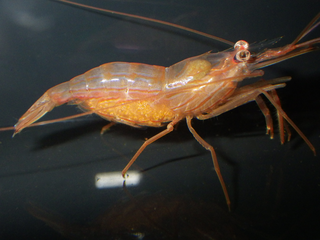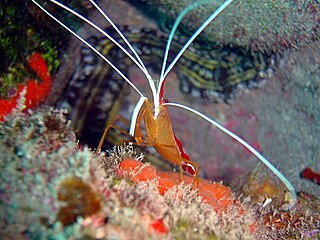
The Caridea, commonly known as caridean shrimp or true shrimp, are an infraorder of shrimp within the order Decapoda. This infraorder contain all species of true shrimp. They are found widely around the world in both fresh and salt water. Many other animals with similar names – such as ghost shrimps, mud shrimps, and boxer shrimps – are not true shrimps, but many have evolved features similar to true shrimps.

The Decapoda or decapods are an order of crustaceans within the class Malacostraca, including many familiar groups, such as crayfish, crabs, lobsters, prawns, and shrimp. Most decapods are scavengers. The order is estimated to contain nearly 15,000 species in around 2,700 genera, with around 3,300 fossil species. Nearly half of these species are crabs, with the shrimp and Anomura including hermit crabs, porcelain crabs, squat lobsters making up the bulk of the remainder. The earliest fossil decapod is the Devonian Palaeopalaemon.

Lysmata amboinensis is an omnivorous shrimp species known by several common names including the Pacific cleaner shrimp. It is considered a cleaner shrimp as eating parasites and dead tissue from fish makes up a large part of its diet. The species is a natural part of the coral reef ecosystem and is widespread across the tropics typically living at depths of 5–40 metres (16–

Sequential hermaphroditism is a type of hermaphroditism that occurs in many fish, gastropods, and plants. Sequential hermaphroditism occurs when the individual changes its sex at some point in its life. In particular, a sequential hermaphrodite produces eggs and sperm at different stages in life. Species that can undergo these changes from one sex to another do so as a normal event within their reproductive cycle that is usually cued by either social structure or the achievement of a certain age or size.

Eucarida is a superorder of the Malacostraca, a class of the crustacean subphylum, comprising the decapods, krill, Amphionides and Angustidontida. They are characterised by having the carapace fused to all thoracic segments, and by the possession of stalked eyes.

Alvinocarididae is a family of shrimp, originally described by M. L. Christoffersen in 1986 from samples collected by DSV Alvin, from which they derive their name. Shrimp of the family Alvinocarididae generally inhabit deep sea hydrothermal vent regions, and hydrocarbon cold seep environments. Carotenoid pigment has been found in their bodies. The family Alvinocarididae comprises 7 extant genera.

Lysmata debelius is a species of cleaner shrimp indigenous to the Indo-Pacific. It is popular in the aquarium trade, where it is known as the fire shrimp, blood shrimp or scarlet cleaner shrimp.
Androdioecy is a reproductive system characterized by the coexistence of males and hermaphrodites. Androdioecy is rare in comparison to the other major reproductive systems: dioecy, gynodioecy and hermaphroditism. In animals, androdioecy has been considered an important stepping stone in the transition from dioecy to hermaphroditism, and vice versa.

Ancylomenes magnificus, also known as the Magnificent Anemone Shrimp, is a species of cleaner shrimp common to the Western Pacific Ocean at depths of 3–29 metres (10–95 ft). They are commonly found on stony coral, Catalaphyllia and the sea anemone, Dofleinia armata.

Lysmata wurdemanni, commonly known as the peppermint shrimp, is a species of shrimp.

Lysmata is a genus of shrimp in the infraorder Caridea, the caridean shrimp. The genus belongs to the family Lysmatidae. Lysmata are popular ornamental shrimp in the marine aquarium trade for their bright color patterns, interesting behaviors, and ability to control certain aquarium pests such as sea anemones of the genus Aiptasia. They are known to command high prices on the pet market.
Lysmata vittata, the peppermint shrimp, is a species of shrimp, native to the Indo-Pacific from East Africa to the Philippines, Japan, Australia and New Zealand.
Phylogeny of Malacostraca is the evolutionary relationships of the largest of the six classes of crustaceans, containing about 40,000 living species, divided among 16 orders. Its members display a great diversity of body forms. Although the class Malacostraca is united by a number of well-defined and documented features, which were recognised a century ago by William Thomas Calman in 1904, the phylogenetic relationship of the orders which compose this class is unclear due to the vast diversity present in their morphology. Molecular studies have attempted to infer the phylogeny of this clade, resulting in phylogenies which have a limited amount of morphological support. To resolve a well-supported eumalacostracan phylogeny and obtain a robust tree, it will be necessary to look beyond the most commonly utilized sources of data.
Campylonotoidea is a superfamily of shrimp, containing the two families Campylonotidae and Bathypalaemonellidae. Fenner A. Chace considered it to be the sister group to the much larger superfamily Palaemonoidea, with which it shares the absence of endopods on the pereiopods, and the fact that the first pereiopod is thinner than the second. Using molecular phylogenetics, Bracken et al. proposed that Campylonotoidea may be closer to Atyoidea. There are sixteen described species in 3 genera; no fossils are known.

Shrimp are decapod crustaceans with elongated bodies and a primarily swimming mode of locomotion – most commonly Caridea and Dendrobranchiata. More narrow definitions may be restricted to Caridea, to smaller species of either group or to only the marine species. Under a broader definition, shrimp may be synonymous with prawn, covering stalk-eyed swimming crustaceans with long narrow muscular tails (abdomens), long whiskers (antennae), and slender legs. Any small crustacean which resembles a shrimp tends to be called one. They swim forward by paddling with swimmerets on the underside of their abdomens, although their escape response is typically repeated flicks with the tail driving them backwards very quickly. Crabs and lobsters have strong walking legs, whereas shrimp have thin, fragile legs which they use primarily for perching.

Lysmata grabhami is a species of saltwater shrimp in the family Hippolytidae. It was first described by Gordon in 1935. It occurs in the tropical and subtropical Atlantic Ocean and is a cleaner shrimp, operating a cleaning station to which fish come to have parasites removed.

Lysmata boggessi is a species of saltwater shrimp first classified as Lysmata wurdemanni. It is found in shallow waters of the Atlantic Ocean, and can be distinguished by its coloration pattern.
Lysmata pederseni is a species of saltwater shrimp first classified as Lysmata wurdemanni. It is found in shallow waters of the Atlantic Ocean, and can be distinguished by its coloration pattern and its association with tube sponges.
Lysmata ankeri is a species of saltwater shrimp first classified as Lysmata wurdemanni. It is found in shallow waters of the Atlantic Ocean, and can be distinguished by its coloration pattern.
Parhippolyte is a genus of cave dwelling decapod crustaceans, known as cave shrimps from the family Barbouriidae The type species Parhipplyte uvea was described in 1900 by the English carcinologist Lancelot Alexander Borradaile from specimens collected in the south western Pacific by Arthur Willey. As their vernacular name of cave shrimp suggests these species are generally found in marine caves as well as anchialine ponds and lagoons.












